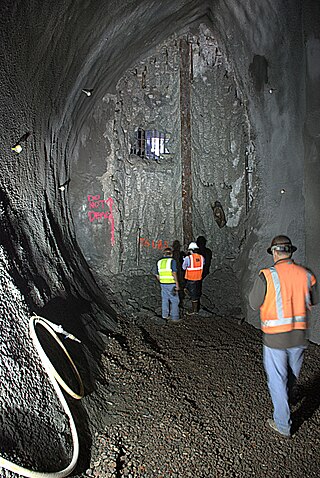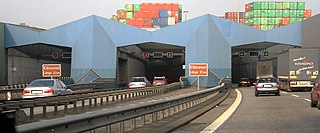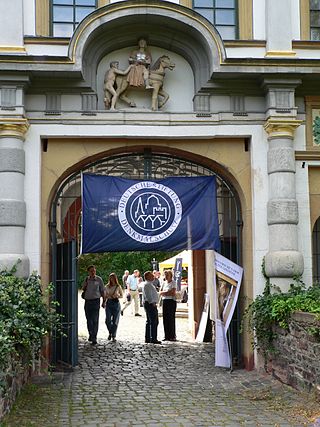
Hamburg, officially the Free and Hanseatic City of Hamburg, is the second-largest city in Germany, after Berlin, and 8th-largest in the European Union, with a population of over 1.9 million. The Hamburg Metropolitan Region has a population of over 5.1 million and is the ninth-biggest metropolitan region by GDP in the European Union.

The Elbe is one of the major rivers of Central Europe. It rises in the Giant Mountains of the northern Czech Republic before traversing much of Bohemia, then Germany and flowing into the North Sea at Cuxhaven, 110 kilometres northwest of Hamburg. Its total length is 1,094 km (680 mi).

A tunnel is an underground or undersea passageway. It is dug through surrounding soil, earth or rock, or laid under water, and is enclosed except for the portals, commonly at each end. A pipeline is not a tunnel, though some recent tunnels have used immersed tube construction techniques rather than traditional tunnel boring methods.

In geotechnical engineering, a caisson is a watertight retaining structure used, for example, to work on the foundations of a bridge pier, for the construction of a concrete dam, or for the repair of ships.

Bundesautobahn 7 is the longest German Autobahn and the longest national motorway in Europe at 963 km. It bisects the country almost evenly between east and west. In the north, it starts at the border with Denmark as an extension of the Danish part of E45. In the south, the autobahn ends at the Austrian border. This final gap was closed in September 2009.

Sandhog is the slang term given to urban miners and construction workers who work underground on a variety of excavation projects in New York City, and later other cities. Generally these projects involve tunneling, caisson excavation, road building, or some other type of underground construction or mining projects. The miners work with a variety of tools including using tunnel boring machines and explosives to remove material for the project they are building. The term sandhog is an American colloquialism.

The New Elbe Tunnel, often simply called Elbtunnel, is a subterranean Elbe River crossing in northern Germany located in Hamburg.

The Clyde Tunnel is a crossing beneath the River Clyde in Glasgow, Scotland for road traffic, cyclists and pedestrians. Two parallel tunnel tubes connect the districts of Whiteinch to the north and Govan to the south in the west of the city.

The Cambie Bridge is a six-lane, precast, box girder bridge spanning False Creek in Vancouver, British Columbia. The current bridge opened in 1985, but is the third bridge at the same location. Often referred to as the Cambie Street Bridge, it connects Cambie Street on the south shore of False Creek to both Nelson and Smithe Streets in the downtown peninsula. It is the easternmost of False Creek's fixed crossings; the Burrard and Granville bridges are a little more than a kilometre to the west, and the new Canada Line SkyTrain tunnel is built just west of the Cambie Bridge.

The Harahan Bridge is a cantilevered through truss bridge that carries two rail lines and a pedestrian bridge across the Mississippi River between West Memphis, Arkansas, and Memphis, Tennessee. The bridge is owned and operated by Union Pacific Railroad and is the second longest pedestrian/bicycle bridge in the United States. It was built with roadways cantilevered off the sides of the main structure for vehicles. These roadways are owned by the cities of Memphis, Tennessee, and Crittenden County, Arkansas, and were used from 1917–1949, until the Memphis & Arkansas Bridge opened 400 feet (120 m) south of the Harahan. The bridge was named in honor of railroad executive James Theodore Harahan, former president of the Illinois Central Railroad, who was killed in a railroad accident during the construction of the bridge. In February 2011, Union Pacific Railroad officials agreed to the idea of converting the 1917 roadways into a bicycle-pedestrian walkway across the river. In June 2012, Memphis was awarded a $14.9 million federal grant to build the walkway. The overall project was expected to cost $30 million, of which about $11 million was used for the Harahan Bridge portion. Construction was completed in 2016.
Elbe tunnel most commonly refers to:

The Big Four Bridge is a six-span former railroad truss bridge that crosses the Ohio River, connecting Louisville, Kentucky, and Jeffersonville, Indiana. It was completed in 1895, updated in 1929, taken out of rail service in 1968, and converted to bicycle and pedestrian use in 2014. The largest single span is 547 feet (167 m), with the entire bridge spanning 2,525 feet (770 m). It took its name from the defunct Cleveland, Cincinnati, Chicago and St. Louis Railway, which was nicknamed the "Big Four Railroad".

The HHLA Container Terminal Altenwerder (CTA) in Hamburg, Germany, is a container handling terminal. It is located in the Altenwerder quarter. It is owned by Hamburger Hafen und Logistik AG (HHLA) (74.9%) and Hapag-LLoyd AG shipping lines (25.1%) and lies south of Hamburg on the river Elbe.

The St. Pauli Piers, is the largest landing site in the Port of Hamburg, Germany, and also one of Hamburg's major tourist attractions. Other English language translations include St. Pauli Landing Stages or St. Pauli Landing Bridges.
The University Medical Center Hamburg-Eppendorf is the teaching hospital of the University of Hamburg and the largest hospital in Hamburg, Germany.

The Internationales Maritimes Museum Hamburg is a private museum in the HafenCity quarter of Hamburg, Germany. The museum houses Peter Tamm's collection of model ships, construction plans, uniforms, and maritime art, amounting to over 40,000 items and more than one million photographs. It opened in a former warehouse in 2008.
Transport in Hamburg comprises an extensive, rail system, subway system, airports and maritime services for the more than 1.8 million inhabitants of the city of Hamburg and 5.3 million people in the Hamburg Metropolitan Region.

Steinwerder is a quarter of Hamburg, Germany in the borough Hamburg-Mitte on the southern bank of the river Elbe. It is a primarily maritime industrial location, with a resident population in 2017 of only 39.

In Japan, the Kanmon Roadway Tunnel carries National Route 2 under the Kanmon Straits. At the time of its construction, it was the longest undersea highway in the world. It opened in 1958. The overall length is 3,461 metres (11,355 ft) meters, and it is 58 metres (190 ft) below sea level at the deepest point. The endpoints are in Shimonoseki, Yamaguchi and Moji-ku, Kitakyūshū. According to a United Press report at the time, 53 workers were killed during its construction, and it was second only to the Mersey Railway tunnel in length for an underwater tunnel.

The Tag des offenen Denkmals is an annual event all over Germany. The day of action has been coordinated by the Deutsche Stiftung Denkmalschutz since 1993. Historic monuments are open to the public free of charge. It takes place on the second Sunday in September and attracts several million visitors each year. The largest cultural event in Germany is the contribution of the country to the European Heritage Days.
























